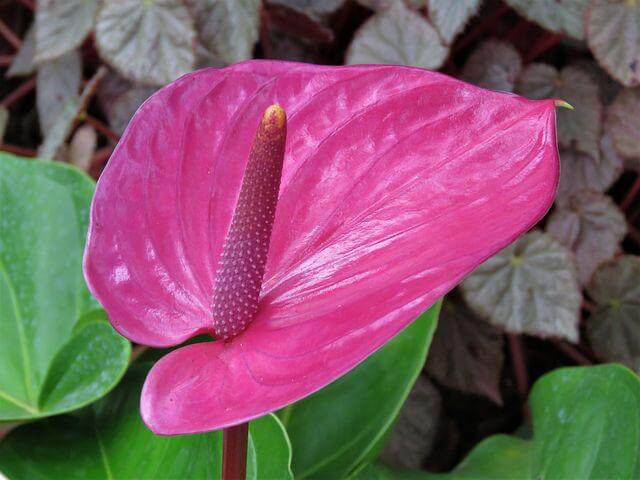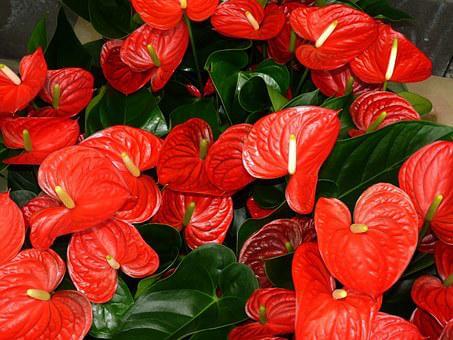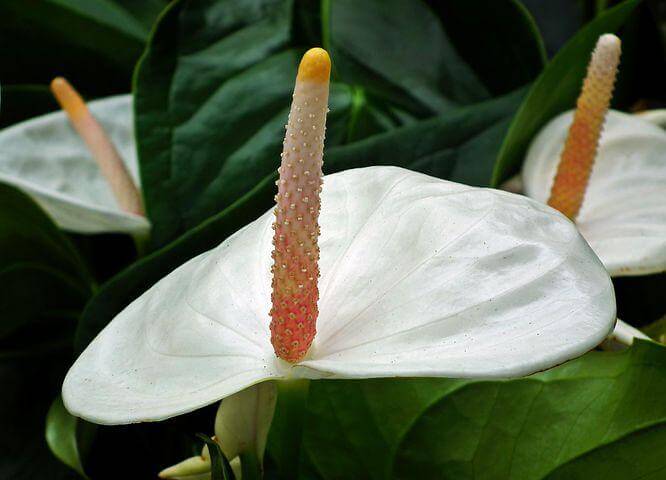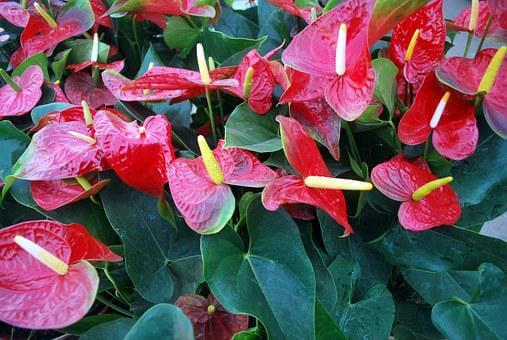Last Updated on January 9, 2023 by a Friendly Gardener
The beautiful brightly colored blooms of this striking tropical perennial come in unique shapes and a variety of hues. An Anthurium houseplant requires minimal care, making it perfect for those without much time or beginner gardeners. The Anthurium contributes color to any décor year-round and flowers last much longer than those of other houseplants.
About the Anthurium

While natives of the tropical forests common to central and South America as well as the Caribbean, these vibrant plants have a name from the Greek language signifying“flowering tails”. A characteristic that distinguishes the Anthurium is that it is an epiphyte or “air plant”.Epiphytes grow on trees, objects, or other plants as a means of physical support. They are not parasitic, and they do not attach to the ground.
Their natural habitats are moist tropical areas, where their capability to grow on other plants and trees assures adequate sunlight within dense forest growth. Tree barks are preferred for physical support. Anthurium plants obtain nutrients from organic debris that forms at a high altitude in tree canopies. The majority of epiphytes either flower or are angiosperms like orchids, tillandsias, or the Bromeliaceae of the Pineapple family.
The Anthurium genus is a member of the Araceae family and is related to dieffenbachia, philodendrons, and peace lilies. Their root systems are woody, with waxy leaves in a variety of shapes and sizes that grow in clusters. Anthurium blooms feature a spadix with numerous petite flowers that are hooded by a vibrantly hued spathe or bract shaped resembling a heart, club, or lance.
With proper care and conditions, the Anthurium will bloom the entire year. Blooms are considerably long-lasting even up to two to three months when they remain on the plant. When cut for use in a bouquet or flower arrangement, they can endure for as much as six weeks.
Caring for the Anthurium

Soil
Anthuriums do not grow naturally in the soil. To reproduce an environment similar to their natural habitat, blend a growing medium using one part peat moss, one part pine or fir bark, and one part pearlite.
When using potting soil, mix two parts orchid potting mix, two parts peat moss, five parts of low-moisture potting soil, and one part pearlite for an optimal blend.
The Anthurium needs a well-draining soil bed that retains moisture but is not wet. You can also use an orchid-growing medium blended with several handfuls of sand and peat moss.
In the natural habitat, an Anthurium plant will lean on its host plant for support, so consider using a trellis or stake for your houseplant to latch onto.
Light
Anthuriums thrive in bright, filtered, or indirect sunlight. In nature, a canopy of jungle trees filters sunlight exposure. Moderate, filtered, indirect light is optimal. Placed in direct sunlight, foliage can scorch.
Water and Humidity
Anthuriums do not do well in soggy soil or stagnant standing water. The soil bed should only remain moist at best. Soil can be monitored with a water meter or simply touch the topsoil to check. Plan on watering weekly in the spring and summer. During dormancy in winter, water every two to four weeks. Your climate will influence your plant’s watering needs.
The best way to water an anthurium plant is by placing it under a sink faucet and running the water until it runs out from the pot’s drainage holes. Drain completely before returning it to its position. Filtered, mineral or distilled water is fine. Tap water needs to be filtered because generally city water will contain chlorine or fluoride.
Anthuriums like humidity. You can mist it occasionally or use a space humidifier. Keep anthuriums away from air conditioning vents, and drafty doorways or windows.
Temperature
Anthurium thrives in temps that are comfortable for humans. They will enjoy the warmth of the growing season but during dormancy, prefer cooler temps. Nonetheless, temperatures should not go lower than 60° Fahrenheit. The ideal temperature should measure from 65°F to 85°F.
Feeding

Feed your anthurium monthly in the growing season using a quality fertilizer with a high phosphorous content diluted to a quarter strength. Do not overfeed. Less is more.
Pruning
It is not necessary to prune extensively your Anthurium. Remove any spent blooms or yellow foliage, trimming at the base of the stem.
Repotting
Anthuriums need repotting at the beginning of each growing season. Should your plant be root bound, repot it regardless of when. Rootbound anthuriums produce roots growing above the soil bed or that peek from drainage holes. Wilting leaves and cracked flower pots are indications that your plant is rootbound.
To repot, water the plant a few hours before repotting to moisten roots. Use a new pot approximately two inches larger than the old one.
Anthurium Water Cultivation

This plant can also be cultivated in water instead of soil. To do so collect a vase, mineral water, and some indoor plant fertilizer. Rinse the plant’s roots to clean them completely of soil. Put the Anthurium in the vase and fill with water until the waterline reaches the plant’s stems. Replace water monthly if not more often and add in a bit of nutrition.
Common Plant Pests, Diseases, and Problems
Aphids, mealybugs, spider mites, scale, and whitefly are all a threat. Wash foliage with insecticidal soap avoiding splashing this on the roots.
Stem or aerial roots can be misted occasionally or removed. Roots sprouting from the soil indicate your anthurium is rootbound and needs repotting.
Yellow foliage may indicate:
- Excessive sunlight
- Excessive watering
- Underwatering
- Rootbound
Look for the cause and intervene.
Anthurium can flower year-round. If yours does not, it may have a problem with care or the environment. Fertilize lightly and move it to a position with better indirect light.
Anthurium Toxicity
Anthuriums are not toxic, but they can irritate humans and pets. Like other Araceaefamily members, they contain calcium oxalate. These are tiny very sharp crystals. When ingested, chewed, or handled, crystals will be released. They cause pain, irritation, and occasionally inflammation. It’s a good idea to keep Anthurium plants where they cannot be accessed by small children and pets.
Anthurium Propagation

The easiest propagation method is through root division. In the spring or summer, when new growth begins, remove the plant from its pot. Divide it into two or more sections if possible and desired. Sections need to have a minimum of three leaves each. Avoid breaking stems and roots and place each section in a new pot.
Another option is to trim off “air roots” found on stems, dip them in rooting hormone, and bury them in new soil in a new pot. Leaves should appear in four to six weeks.
Cuttings are also a possibility. Trim a stem with at least three leaves and treat the cut end with rooting hormone. Place it in the soil bed up to its first leaf. Water when the soil dries and mist it weekly. In four to six weeks, roots should begin to develop.
All Things Considered
Anthuriums with lush foliage and vividly colored blooms will brighten any space. As a low-maintenance plant, it’s the perfect gift for friends and family and especially beginner gardeners.

